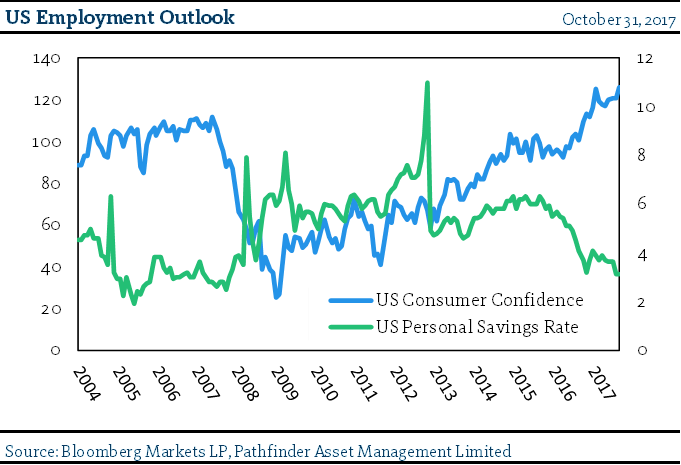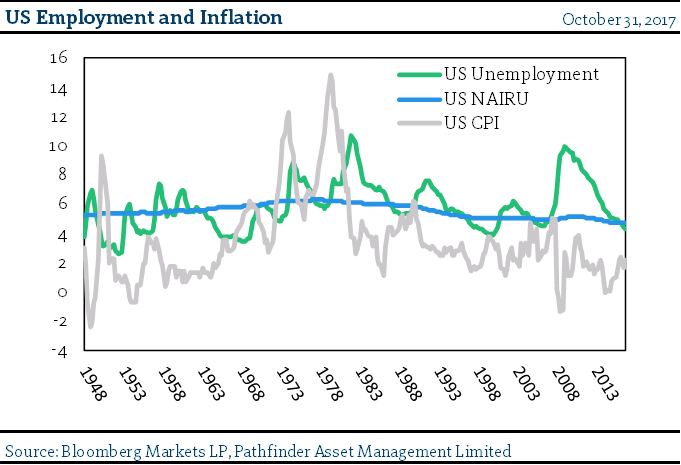Recap & Macro Outlook: Employment
We continue to focus on US Employment as a harbinger of inflation and, ultimately, an eventual sustained increase in administered interest rates. We also watch Consumer Confidence which has hit a 17-year high and the US Personal Savings Rate which has hit a 10-year low. Both data points are plotted in the first chart. If savings rates are low and confidence is high, then it makes sense that US workers are enjoying a good labour market. This should ultimately lead to higher wages, squeezing corporate profits and pushing prices for goods and services higher.

The US Congressional Budget Office publishes a statistic called the Non-Accelerating Inflation Rate of Unemployment (NAIRU), which is defined as the lowest level of unemployment that will not contribute to inflation acceleration. It is more commonly called the “natural rate” of unemployment. In the chart to the right, we have plotted the regular US Unemployment rate along with the NAIRU and the US inflation rate. Many economists think that the goal of monetary policy should be to employ just enough people so that inflation will not take hold. This is a difficult thing to do. What we have noticed is that the current unemployment rate is now lower than the natural unemployment rate. In the past, when that difference gets extreme (difference between the blue line and the green in the second chart), inflation has taken hold (grey line). Two Fridays ago, the US Department of Labor released the monthly jobs report and unemployment rate dropped again to 4.1%. If the unemployment rate were to fall further below 4% (i.e. in the 3’s), then we would be approaching this extreme level again.

“This means that” we will watch the state of the North American labour market for hints of inflation. Central Banks will ultimately react to inflationary data. This will cause valuation implications for the companies in our portfolios.
National Instrument 31-103 requires registered firms to disclose information that a reasonable investor would expect to know, including any material conflicts with the firm or its representatives. Doug Johnson and/or Pathfinder Asset Management Limited are an insider of companies periodically mentioned in this report. Please visit www.paml.ca for full disclosures.
*All returns are time weighted and net of investment management fees. Returns from the Pathfinder Partners’ Fund and Partners’ Real Return Plus Fund are presented based on the masters series of each fund. The Pathfinder Core: Equity Portfolio and The Pathfinder Core: High Income Portfolio are live accounts. These are actual accounts owned by the Pathfinder CEO (Equity) and client (High Income) which contain no legacy positions, cash flows or other Pathfinder investment mandates or products. Monthly inception dates for each fund and portfolio are as follows: Pathfinder Core: Equity Portfolio (January 2011), Pathfinder Core: High Income Portfolio (October 2012) Partners’ Fund (April 2011), Partners’ Real Return Plus Fund (April, 2013), and Partners’ Core Plus Fund (November 2014).
Pathfinder Asset Management Limited (PAML) and its affiliates may collectively beneficially own in excess of 10% of one or more classes of the issued and outstanding equity securities mentioned in this newsletter. This publication is intended only to convey information. It is not to be construed as an investment guide or as an offer or solicitation of an offer to buy or sell any of the securities mentioned in it. The author has taken all usual and reasonable precautions to determine that the information contained in this publication has been obtained from sources believed to be reliable and that the procedures used to summarize and analyze such information are based on approved practices and principles in the investment industry. However, the market forces underlying investment value are subject to sudden and dramatic changes and data availability varies from one moment to the next. Consequently, neither the author nor PAML can make any warranty as to the accuracy or completeness of information, analysis or views contained in this publication or their usefulness or suitability in any particular circumstance. You should not undertake any investment or portfolio assessment or other transaction on the basis of this publication, but should first consult your portfolio manager, who can assess all relevant particulars of any proposed investment or transaction. PAML and the author accept no liability of any kind whatsoever or any damages or losses incurred by you as a result of reliance upon or use of this publication.